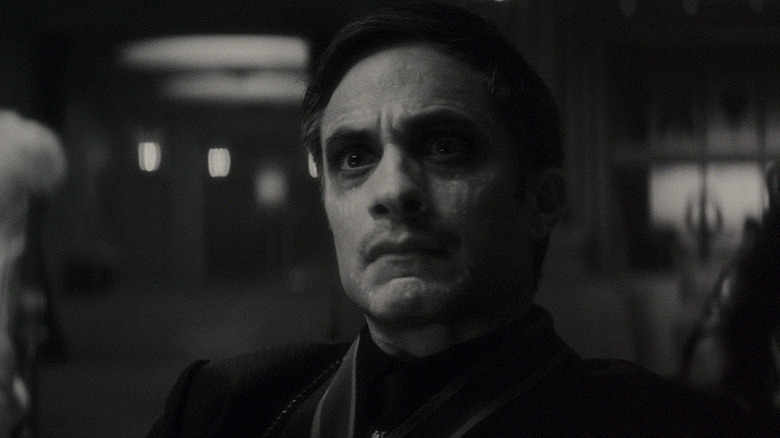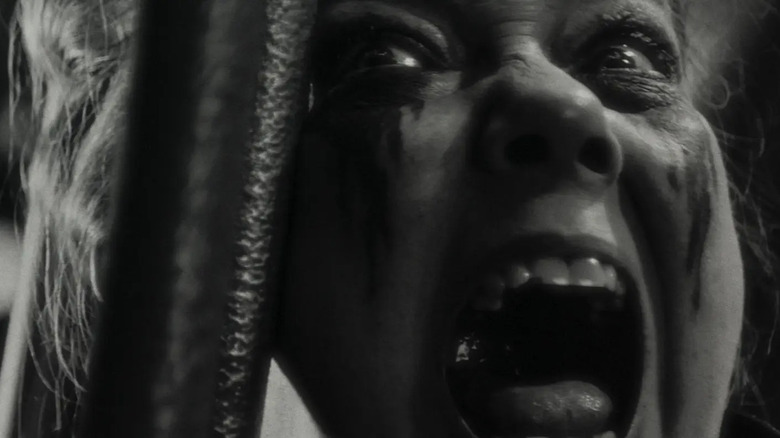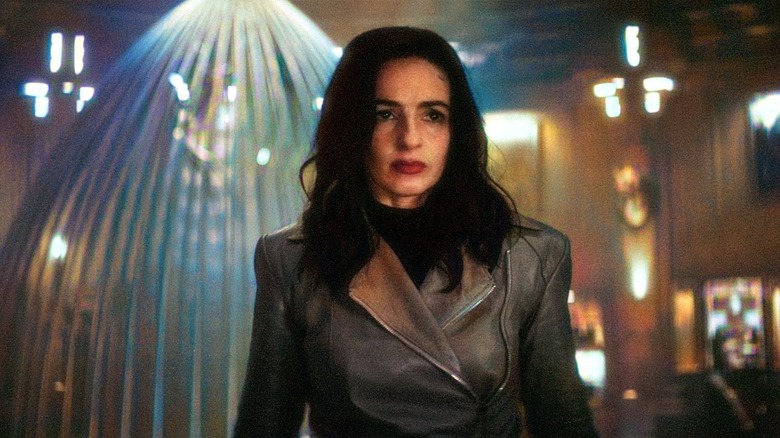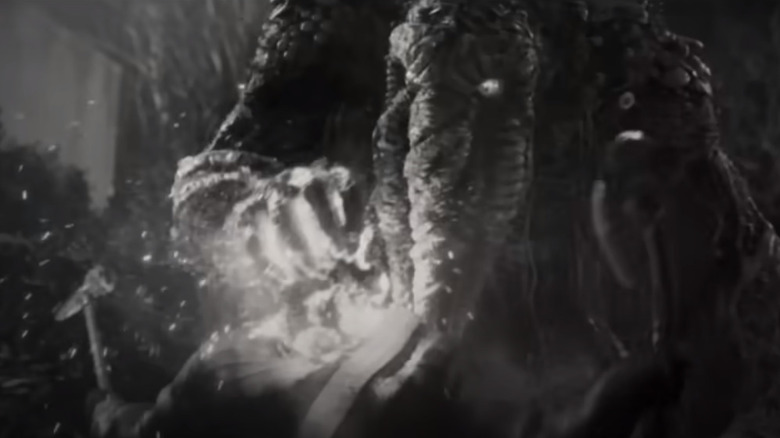Werewolf By Night Ending Explained: Monsters Are Real
This article contains spoilers for "Werewolf by Night."
"Werewolf by Night," the latest film in the Marvel Cinematic Universe, is being presented as a "special presentation." This means, one can presume, that its events won't be as heavily incorporated into the rest of the MCU in the same fashion its theatrical counterparts are. "Werewolf By Night" comes from a specially branded corner of Marvel Comics usually reserved for monsters, demons, and other supernatural creatures of the night. Ghost Rider, Blade, and Morbius the Living Vampire also hail from this corner. Werewolf by Night was originally created in 1972 by Roy Thomas, Jean Thomas, Gerry Conway, and Mike Ploog. The character is a man named Jack Russell (nothing to do with the breed of terrier) who, true to his name, becomes a wolf man every full moon. Fittingly, the original "Werewolf by Night" comics were written by a man named Marv Wolfman.
Because the MCU has become as elaborate and strange as it has in the 14 years since its inception — will anyone address Vision's "Civil War" concerns that there seem to be more and more superheroes appearing all the time now? — "Werewolf by Night" makes no efforts to ease viewers into the fact that werewolves and monsters are a real, regular part of the world. Gael García Bernal plays Jack Russell, a man who is a werewolf and also a monster hunter, and who has been invited to a powwow with Earth's mightiest Van Helsings. The monster hunters are let loose in an elaborate labyrinth to kill one another in competition for a MacGuffin that will make the winner the Lord of the Monster Hunters.
By the end of the film, Russell's secrets are revealed.
Giant-Size Man-Thing
Russell, in fact, has two secrets. Not only do the other monster hunters not know that he is a werewolf, but his is also friends with another monster. Hiding out in the film's labyrinth is none other than Man-Thing, a towering humanoid swamp monster that first appeared in Marvel Comics in 1971. Man-Thing also previously appeared in his own 2005 feature film director by Brett Leonard. The character was hardly the first comic book swamp creature, having been inspired by the 1942 character Heap. Man-Thing predates DC comics' Swamp Thing by only about two months. Whether or not one comic company ripped off the other is a matter of some debate.
Man-Thing, by the lore of Marvel Comics, was a scientist named Dr. Ted Sallis who was hoping to recreate the same steroid that created Captain America. Under duress, Dr. Sallis injected himself with an untested formula while in the Florida everglades, coincidentally stumbled onto some magical forces, and emerged on the other end as a non-verbal, slow-thinking moss hulk. In "Werewolf By Night," Man-Thing has somehow been locked in a monster hunter's labyrinth, and Jack Russell has joined the film's central monster hunt specifically to break him out. He and Man-Thing are old friends. Russell makes use of a time bomb to blow a hole in the maze's outer wall and let Ted free.
This act draws attention to Russell, and the leader of the hunt, Verusa (Harriet Sansom Harris) immediately discovers that he is a monster himself. She uses her own mystical means to force him to transform, even though it is not a full moon. Russell, quite tragically, knows that he is destined to kill his new ally Elsa Bloodstone (Laura Donnelly) and anyone else who stands in his way.
The Bloodstone
"Werewolf by Night" was shot mostly in black and white in what appears to be an aesthetic homage to George Waggner's 1941 classic "The Wolf Man." Giacchino's film even features fake cue marks in the screen's upper right hand corner, and some fake film scratches to give the special a vintage feel. Never mind that Giacchino shot his film in a 2.39:1 aspect ratio, a format that wasn't introduced until 1953. By the end of the film, the black and white fades to color.
The above-mentioned MacGuffin — the Bloodstone — once belonged to a man named Ulysses Bloodstone, now a clockwork corpse in a coffin. The corpse, via grinding servos and a pre-recorded narration, describes the details of the hunt to the gathered monster hunters, all costumed and well-armed. Verusa is Ulysses' widow. Ulysses Bloodstone was a dashing monster hunting superhero in 1970s Marvel comics. The Bloodstone itself was an ancient magical meteor that gave its owner eternal life. By the end of "Werewolf by Night," Elsa Bloodstone, UIysses' estranged daughter, reclaims the stone and Verusa is slain, killed by Russell in werewolf form.
The implication at the end is that Elsa, a more open-minded character than Verusa, will now become the leader of Earth's monster hunters, but with a more compassionate eye. Not all monsters, she has now learned through her encounter with Russell and Ted, are evil beings that must be murdered. As the film fades to color, "Somewhere Over the Rainbow" plays on the soundtrack. Fans of the MCU likely intuit that Elsa will reappear in future chapters of the franchise, and the Bloodstone — a powerful, magical rock — will come into play very much the way the Infinity Stones did in the first 19 movies.
Everything is real
To briefly address Vision's concern, mentioned above...
In Anthony and Joe Russo's 2016 film "Captain America: Civil War," the thirteenth film in the MCU, the android character of Vision (Paul Bettany) argued — logically and sanely — that superhero characters should perhaps subject themselves to some kind of oversight in order to keep their rogue powers in check. Vision pointed out that, 13 films into the series, there were already dozens of superhuman figures on Earth, and the number only seemed to be increasing. The MCU, back when it started in 2008, still took place in essentially the real world. By "Civil War," reality had already been rent asunder. Comic book fans naturally understood the ever-growing roster; there were decades of comic book history to recreate and to draw from. But the character should, perhaps, be a little more astonished that the world was normal five years ago and is not now.
This might have been the MCU's final attempt to connect itself to the real world. Attempts had been made to stage Thor as a space alien and not a legit deity, and the Guardians of thje Galaxy were comedy sci-fi characters that hadn't directly linked with the earthbound characters quite yet. The next film in the series, Scott Derrickson's "Doctor Strange," left behind any notion that there is a scientific explanation for the MCU, and stated plainly that magic was real. Now that "wizard magic" was a plot point, reality was obliterated. Now, anything is possible and no explanation is needed.
"Werewolf by Night" says that monsters are real, and there's nothing astonishing about that. Werewolves are a thing. Swamp beasts are friendly buddies who know how to operate a French press. The MCU has, as ever, made the extraordinary into something quotidian.



